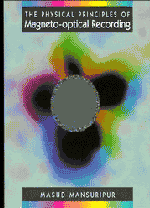Book contents
- Frontmatter
- Contents
- Preface
- 1 Overview of Optical Data Storage
- 2 Optics of Gaussian Beams
- 3 Theory of Diffraction
- 4 Diffraction of Gaussian Beams from Sharp Edges
- 5 Optics of Thin Films and Multilayers
- 6 Magneto-optical Readout
- 7 Effects of High-numerical-aperture Focusing on the State of Polarization
- 8 Computer Modeling of the Optical Path
- 9 Noise in Magneto-optical Readout
- 10 Modulation Coding and Error Correction
- 11 Thermal Aspects of Magneto-optical Recording
- 12 Fundamentals of Magnetism and Magnetic Materials
- 13 Magnetostatics of Thin-film Magneto-optical Media
- 14 Mean-field Analysis of Amorphous Rare Earth–Transition Metal Alloys
- 15 Magnetization Dynamics
- 16 Origins of Coercivity
- 17 The Process of Thermomagnetic Recording
- 18 Media Characterization
- References
- Index
14 - Mean-field Analysis of Amorphous Rare Earth–Transition Metal Alloys
Published online by Cambridge University Press: 07 September 2010
- Frontmatter
- Contents
- Preface
- 1 Overview of Optical Data Storage
- 2 Optics of Gaussian Beams
- 3 Theory of Diffraction
- 4 Diffraction of Gaussian Beams from Sharp Edges
- 5 Optics of Thin Films and Multilayers
- 6 Magneto-optical Readout
- 7 Effects of High-numerical-aperture Focusing on the State of Polarization
- 8 Computer Modeling of the Optical Path
- 9 Noise in Magneto-optical Readout
- 10 Modulation Coding and Error Correction
- 11 Thermal Aspects of Magneto-optical Recording
- 12 Fundamentals of Magnetism and Magnetic Materials
- 13 Magnetostatics of Thin-film Magneto-optical Media
- 14 Mean-field Analysis of Amorphous Rare Earth–Transition Metal Alloys
- 15 Magnetization Dynamics
- 16 Origins of Coercivity
- 17 The Process of Thermomagnetic Recording
- 18 Media Characterization
- References
- Index
Summary
Introduction
In Chapter 12 we described the mean-field theory of magnetization for ferromagnetic materials, which consist of only one type of magnetic species. The atoms (or ions) comprising a simple ferromagnet are coupled via exchange interactions to their neighbors, and the sign of the exchange integral ℐ is positive everywhere. In this chapter we develop the mean-field model of magnetization for amorphous ferrimagnetic materials, of which the rare earth–transition metal (RE–TM) alloys are the media of choice for thermomagnetic recording applications. Ferrimagnets are composed of at least two types of magnetic species; while the exchange integral for some pairs of ions is positive, there are other pairs for which the integral is negative. This leads to the formation of two or more subnetworks of magnetic species. When the ferrimagnet has a uniform temperature, each of its subnetworks will be uniformly magnetized, but the direction of magnetization will vary among the subnetworks. In simple ferrimagnets consisting of only two subnetworks, the magnetization directions of the two are antiparallel.
In thin-film form, amorphous RE–TM alloys exhibit perpendicular magnetic anisotropy, which makes them particularly useful for polar Kerr (or Faraday) effect readout. Being ferrimagnetic, they possess a compensation point temperature, Tcomp, at which the net moment of the material becomes zero. Tcomp can be brought to the vicinity of the ambient temperature by proper choice of composition. This feature preserves uniform magnetic alignment in the perpendicular direction by preventing the magnetization from breaking up into domains.
- Type
- Chapter
- Information
- The Physical Principles of Magneto-optical Recording , pp. 515 - 542Publisher: Cambridge University PressPrint publication year: 1995



